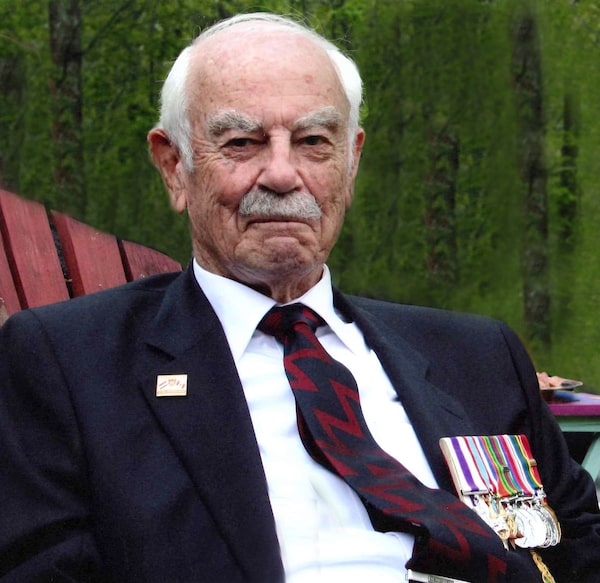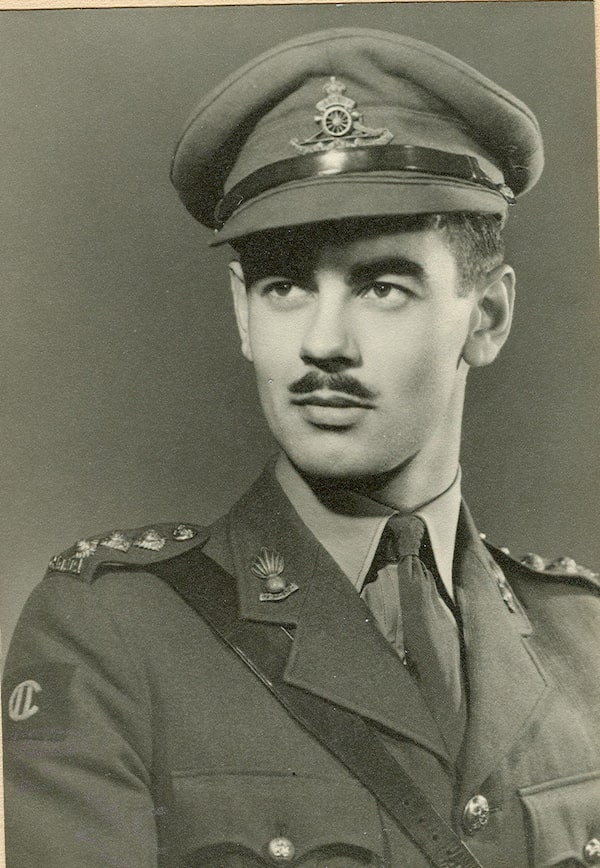
Arthur Britton Smith, war hero and philanthropist.Handout
Twenty-four-year-old artillery captain Arthur Britton Smith, a tall, lean professional soldier with a jaunty Rhett Butler mustache, landed at Normandy in July, 1944, a month after D-Day. He had trained for four years but his war was a short one.
Just three weeks after arriving in France, Capt. Smith was headed back across the English Channel on a stretcher, one of 1,500 Canadian casualties from a futile single-day assault on Verrières Ridge.
The dashing young war hero survived his wounds and over the next eight decades built one of the country’s largest apartment rental companies and shared his millions with dozens of local charities and institutions.
Brit, as he was best known, died peacefully on Oct. 28 at age 103.
Arthur Britton Smith was born in Kingston, Ont., on May 10, 1920, to Cyril and Edna Smith. Although his father was a lawyer, he had the army on his mind and launched his military career on his 15th birthday by joining the city’s 32nd Field Battery, an artillery militia unit. “The next day,” Mr. Smith recounted to Kingston’s Profile Magazine in 2007, “I was wearing spurs and britches. … I was a boy soldier.”
On the advice of his officers, he enrolled in the Royal Military College (just across the Cataraqui River from his home), graduating in 1940, less than a year after the outbreak of war in Europe. By August, he was in England with the Royal Canadian Artillery.
When he finally reached France on July 7, 1944, Capt. Smith was a troop commander in the 4th Field Regiment in charge of four 25-pounder gun crews. The D-Day troops who had landed on Juno Beach had fought for a month but only advanced 22 torturous kilometres from the coast; the Normandy countryside was a smouldering ruin by the time Capt. Smith rode his lightly armoured Bren gun carrier to the front line.
On July 20, Capt. Smith went into action with a company of Les Fusiliers Mont-Royal as a forward observation officer (FOO), a dangerous battle assignment that attracted close attention from German snipers eager to end the deadly accurate fire of the Allies’ howitzers.

Arthur Britton Smith in his military uniform.Handout
Moving slowly with Les Fusiliers Mont-Royal toward entrenched SS troops, Capt. Smith disguised himself as an infantry rifleman, hiding his powerful binoculars and maps inside his uniform and covering his officer shoulder pips with a camouflage scarf. He carried a rifle to complete the deception.
During a difficult two-kilometre advance to Troteval Farm, Capt. Smith directed a creeping barrage that delivered a moving curtain of explosives ahead of Les Fusiliers Mont-Royal to destroy enemy positions. Once the farm had been captured, he divided his time between identifying targets and co-ordinating defence of the old stone farmyard until he was slightly injured by a small grenade. Pursuing his attacker through an opening in a stone wall, he was hit by a burst of machine gunfire.
Writing in the academic journal Canadian Military History 60 years later, he recalled, “I felt like I had been kicked in the gut, but there was no blood.” The clunky plastic body armour he was wearing had absorbed the bullets’ impact.
The following day, Troteval Farm withstood five attacks as the Germans tried to recapture it with infantry, armour and artillery. Capt. Smith directed fire on them with his battery’s 24 guns, each one firing up to 600 shells that day. When he wasn’t on the radio, he fought off the enemy with a rifle. Finally, with only 17 defenders left fighting, the company’s commander decided to surrender, authorizing Capt. Smith to call for one more barrage on their own location as Germans entered the farmyard.
Machine guns raked Capt. Smith’s carrier as he and his radio operators raced back to their own regiment less than a kilometre away. He was later awarded the Military Cross for “his coolness and bravery under heavy fire as well as his complete disregard for his own safety.”
Capt. Smith’s luck ran out four days later when his vehicle hit an anti-tank mine. Crawling away from the wreck, he was shot in the head but was rescued before bleeding to death.
After a brief convalescence, Capt. Smith returned to Kingston to great fanfare and married Sally Carruthers. By 1948, he was practising law in Kingston and dabbling in real estate.
He constructed his first apartment building – an eight-unit low-rise on a $1,000 lot at the edge of the city – while still a student at Osgoode Hall, hiring a Kingston neighbour to build it, and travelling home on weekends to oversee progress.
Mr. Smith continued his Kingston real-estate pursuits as a sideline to his law practice and averaged a new apartment building a year, looking in on construction sites on his way to his law office. In 1954, he incorporated his real-estate business as Homestead Land Holdings Ltd. and raised his ambitions. Today, the company owns 26,000 apartment units in 16 Ontario cities (and a single high-rise in Calgary). While billing itself as Ontario’s largest landlord, Homestead remains focused primarily on Kingston, where it has 44 buildings.
While Homestead is generally well regarded by individual tenants, its high-profile projects have regularly met fierce opposition from community groups. The company has faced long fights – and occasional defeats – over several proposed developments in prime locations along Kingston’s waterfront and in historical neighbourhoods.
City councillor Conny Glenn, chair of Kingston’s two heritage committees, notes that Mr. Smith’s position – “one foot in the past and one foot in the future” – was complex. “Despite the conflicts,” she says, “He was appreciative of heritage. … It wasn’t a perfect situation, but he had good intent.”
While Homestead’s executives shun publicity, Mr. Smith provided a friendly face, mingling easily with the city’s establishment families, charities and public institutions like Queen’s University and the Kingston General Hospital.
Kingston Profile magazine publisher Bonnie Golomb, a lifelong resident of the city, marvels that Mr. Smith kept his hometown the focus of his life. “He could have lived anywhere but he stayed in Kingston. He was very social but humble and self-deprecating. … He always said Homestead was his hobby.”
Indeed, Mr. Smith had many other interests beside law and real estate. After the war, he joined the local Prince of Wales Own Regiment, an infantry militia unit, eventually becoming its honorary commanding officer. He also served three terms on city council in the 1950s.
As his personal wealth grew, he invested money as well as time into his local interests. When new road construction blocked access to a Memorial archway, he shouldered much of the cost to relocate it – using his own construction crews to rebuild its limestone walls.
“Brit was a very active supporter of RMC,” recalls the school’s former commandant, Commodore (retired) Ed Murray. “He appreciated tradition.” Several years ago, Mr. Smith purchased 1,400 white pith helmets to be worn by cadets with their scarlet tunics, reviving a long-time tradition that the government refused to fund.
His other donations were less esoteric. Through his foundation, Mr. Smith gifted millions of dollars to Queen’s University’s medical and nursing schools, St. Lawrence College, the United Way, and Kingston hospitals. Frustrated by the city’s failure to secure a permanent home for the Marine Museum of the Great Lakes, in 2019 he funded the purchase of its original lakefront facility from a rival developer for $3.2-million. In 2022, the Smith-Homestead Foundation donated $1-million to Home Base Housing, a charity for disadvantaged youth.
On his 100th birthday, a year after he was named to the Order of Canada in 2019, Mr. Smith playfully talked about his money with the Kingston Whig-Standard. “What else can I do with it?” he asked. “When you get to my age, it’s hard to figure out a way to spend money. I’m too old for most things.”
Predeceased by Sally, his wife of 68 years, and his son Britton, Mr. Smith leaves two sisters; his son Alexander; daughter, Sheila; their children; and his partner, Margaret Daicar.